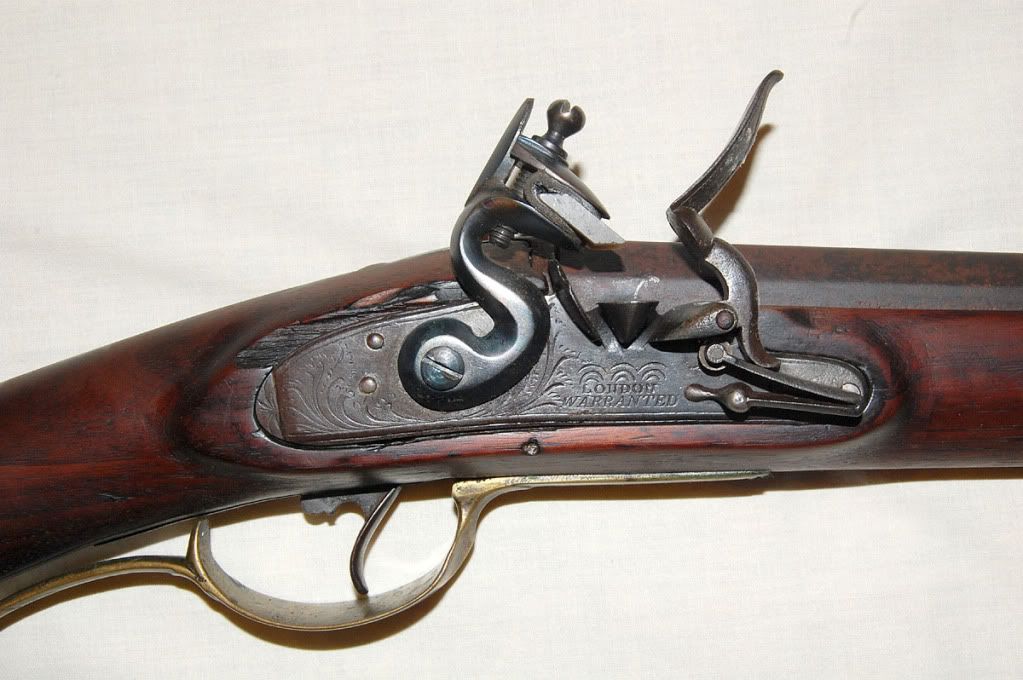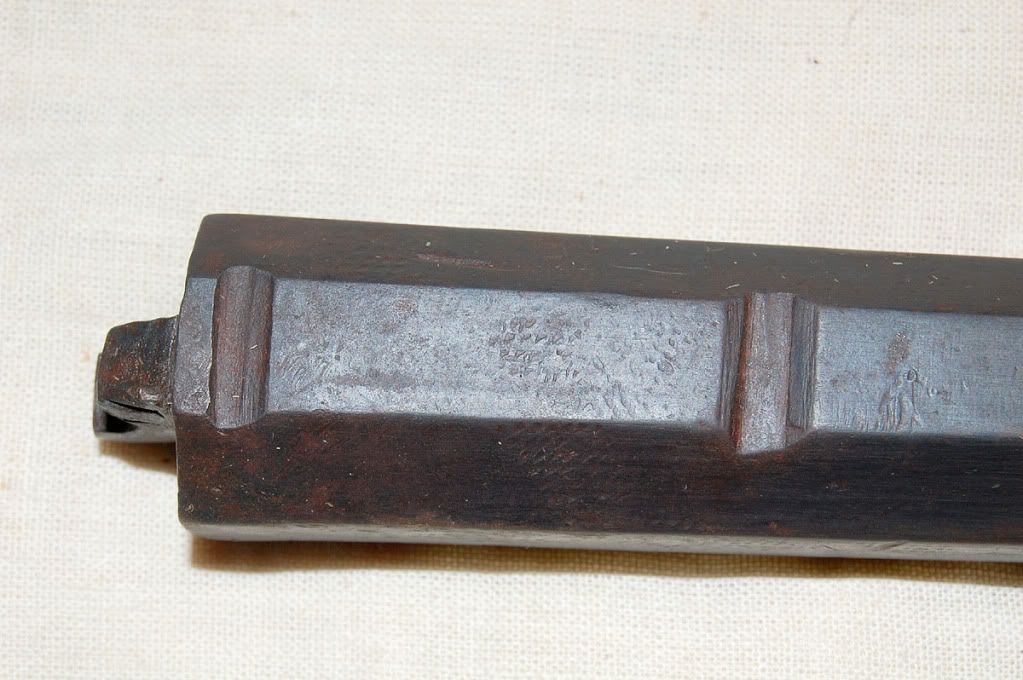Please take a look at this rifle and let me hear what you think, My apologies, I suspect this will be longish. In Dec. 1989 I was in the market for a flintlock smoothbore and went to an auction with an “early American fowler” advertised. Inspection at the auction showed an unusually long and slender gun, seemingly just what I was looking for. I bought it. When I got it home I found several surprises. It has an octagon barrel 49 1/8” long, 1 1/8” at the breech, tapered to 3/4” at 8” from the muzzle, then flared back to 7/8” at the muzzle. Thickness of the barrel wall diminishes from breech to muzzle so that it is impressively lightweight and well balanced for its length. Overall length is 64 inches, weight is 6 lb. 15 oz. Surprise #1 was that the 20 ga. barrel was actually a 28 ga. barrel with the last 1 1/2” of bore flared to 20 gauge at the muzzle. There is no sign of rifling, but I have no way to visually inspect the bore. Surprise #2 was that it has a hook breech which is apparently not a modern addition. Surprise #3 is that the barrel itself is apparently hand forged, and forging marks can be seen on the underside, or so says a man who knows about forged barrels.
Stock is walnut, plain, with no cheek piece, carvings or inlays. The barrel channel is round-bottomed, not octagon to match the barrel. The barrel is held to the stock by 4 headless keys of brass. The staples under the barrel made to accept the keys are hand forged and attached to plates which are then dovetailed into the barrel. There is a groove filed under the barrel at the breech to clear the forward lock bolt... actually there are two grooves 1” apart, because the barrel has been shortened by one inch at some time.
The trigger guard, butt plate, entry thimble and two ramrod thimbles are of old brass. There is no side plate, but escutcheons for the lock bolts are brass, teardrop shaped forward and oval rear. The butt plate is fastened with two screws at the toe.
There is a very low brass barleycorn front sight set into a dovetail. There is no rear sight, no sign there ever was one..
The lock is of the small rifle type, and is of an ingenious waterproof design I’ve never seen. The lock plate is 4 1/2 inches long, curved and marked with nice engraving and LONDON WARRENTED. There is a roller on the frizzen spring tip. The lock has bridle and stirrup and a fly. The hammer is a fairly obvious replacement and doesn’t match the rest of the gun well.
The trigger is simple, iron, wide and filed with a decorative shape. It is set into a triangular trigger plate which accepts the tang screw and does not extend under the front trigger guard tang.
Not sure whether I had an old gun or a marriage of old parts, I took it to Woodbury, Ky. to let Herschel House look at it. By chance Frank House was there, so both of them gave it the evil eye for a fair chunk of the afternoon, inside and out.. Their opinion was:
It is an old gun, and all the parts except the hammer are original to it.
It was originally a gun from the mid-18th century to Rev. War time frame, but was restocked at a later date when stock styles had changed, sometime in early 19th century..
Hook breech guns are known as early as 1700 and that may have been the original configuration. Or, it could have been reconfigured at the time of the restocking.
The barrel has been shortened by 1”, probably because of burnout in the breech area. It may have been a rifled gun which was freshened as a smoothbore at that time, no way to tell.
The double screws in the toe of the butt plate probably indicate that a wider, thicker butt was cut down to a more fashionable style during the restocking. The extra screw is there because the old one wound up too near the toe to guarantee security, so they added a new one.
The lock is of good quality but was not made by the gunsmith, rather imported from England. The marking LONDON WARRANTED was common on imported locks.
Sorry to run on so . Some pictures, tell me what you think.
Spence











Stock is walnut, plain, with no cheek piece, carvings or inlays. The barrel channel is round-bottomed, not octagon to match the barrel. The barrel is held to the stock by 4 headless keys of brass. The staples under the barrel made to accept the keys are hand forged and attached to plates which are then dovetailed into the barrel. There is a groove filed under the barrel at the breech to clear the forward lock bolt... actually there are two grooves 1” apart, because the barrel has been shortened by one inch at some time.
The trigger guard, butt plate, entry thimble and two ramrod thimbles are of old brass. There is no side plate, but escutcheons for the lock bolts are brass, teardrop shaped forward and oval rear. The butt plate is fastened with two screws at the toe.
There is a very low brass barleycorn front sight set into a dovetail. There is no rear sight, no sign there ever was one..
The lock is of the small rifle type, and is of an ingenious waterproof design I’ve never seen. The lock plate is 4 1/2 inches long, curved and marked with nice engraving and LONDON WARRENTED. There is a roller on the frizzen spring tip. The lock has bridle and stirrup and a fly. The hammer is a fairly obvious replacement and doesn’t match the rest of the gun well.
The trigger is simple, iron, wide and filed with a decorative shape. It is set into a triangular trigger plate which accepts the tang screw and does not extend under the front trigger guard tang.
Not sure whether I had an old gun or a marriage of old parts, I took it to Woodbury, Ky. to let Herschel House look at it. By chance Frank House was there, so both of them gave it the evil eye for a fair chunk of the afternoon, inside and out.. Their opinion was:
It is an old gun, and all the parts except the hammer are original to it.
It was originally a gun from the mid-18th century to Rev. War time frame, but was restocked at a later date when stock styles had changed, sometime in early 19th century..
Hook breech guns are known as early as 1700 and that may have been the original configuration. Or, it could have been reconfigured at the time of the restocking.
The barrel has been shortened by 1”, probably because of burnout in the breech area. It may have been a rifled gun which was freshened as a smoothbore at that time, no way to tell.
The double screws in the toe of the butt plate probably indicate that a wider, thicker butt was cut down to a more fashionable style during the restocking. The extra screw is there because the old one wound up too near the toe to guarantee security, so they added a new one.
The lock is of good quality but was not made by the gunsmith, rather imported from England. The marking LONDON WARRANTED was common on imported locks.
Sorry to run on so . Some pictures, tell me what you think.
Spence


















